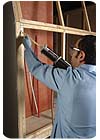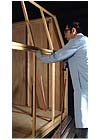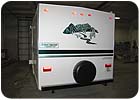A Strong Bond

Elkhart, IN-based Startracks specializes in building custom mobile vehicles used as medical clinics, law-enforcement command posts and motorcycle transport units. The company also manufactures mobile homes for wheelchair-bound customers. These handicapped-accessible vehicles contain such features as extra-wide doors and center aisles and bathrooms large enough to accommodate wheelchairs. ARALDITE 2011 epoxy adhesive supports Startracks in the production of different vehicle designs because it bonds wood, metal and FRP substrates quickly and effectively. Once cured, the adhesive features a lap-shear strength of 2,560 psi and roller peel strength of 28 pli; it also exhibits good resistance to static and dynamic loading.
*Filon is a registered trademark of Kemlite Co. Inc.

Vehicle Construction
Typical of the projects Startracks has handled recently is a trailer for a handicapped customer to use as a summer home. The interiors are designed to be fully wheelchair accessible. The frame is wood and the exterior skin is Filon FRP sheet. Wood was selected as an economical material for the frame, and, because the unit will be parked rather than towed, weight was not an issue. For mobile vehicles, the substructure is typically lighter-weight aluminum with a fiberglass or aluminum skin. When bonding metal frames and/or skins, surfaces are first abraded to improve adhesion.To begin construction of the trailer exterior, technicians insert a 200-ml cartridge of the epoxy adhesive into a pneumatic dispensing gun and add a disposable static mixing nozzle. Then, a small amount of resin and hardener is extruded onto scrap cardboard to ensure complete blending of the adhesive components. Next, adhesive is applied to the trailer frame (see Photo 1). The epoxy adhesive has an easy-to-work-with mixed viscosity of 45,000 cP and a 120-minute work life that is well-suited for bonding large surface areas. Next, the FRP-laminated exterior panel is positioned over the substructure and clamped in place using metal beams (see Photo 2). The adhesive cures in 12 hours at room temperature. The same basic process is used for the range of vehicles built by Startracks.

For more information on epoxy adhesives, contact Huntsman Advanced Materials at http://www.huntsman.com .
Links
Looking for a reprint of this article?
From high-res PDFs to custom plaques, order your copy today!



